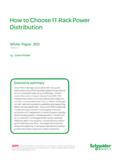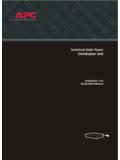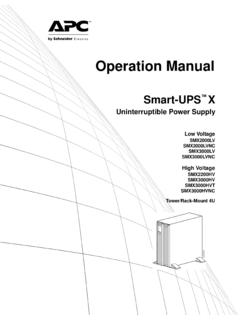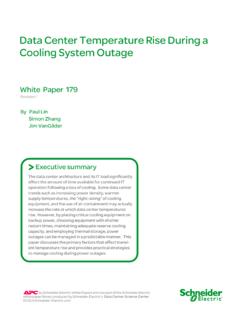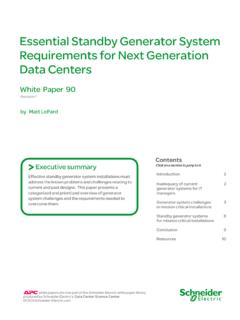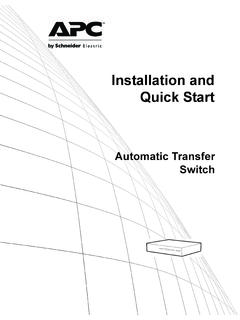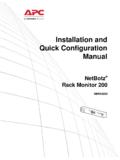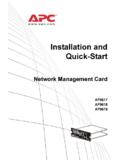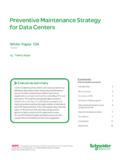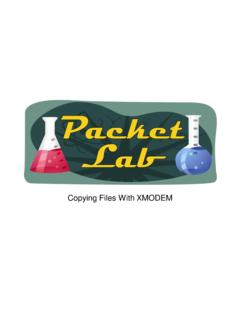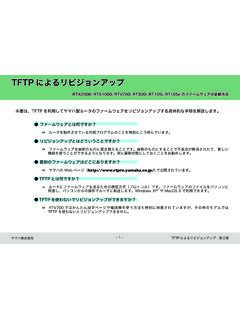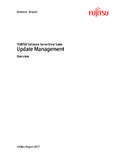Transcription of About This Guide 1 Purpose of the Guide - - APC USA
1 REFERENCE GUIDEM anagement Information BaseContentsiAbout this Guide --1 Purpose of the Guide ..1 Related Documents and Files ..1 PowerNet MIB Structure--2 Traps..2 OIDs ..2 Manage Agents and Management Cards--5 Locate the OIDs..5 Monitor a PowerNet Agent..5 Manage an SNMP Agent of a Hardware Device ..6 PowerNet MIB Traps--10 Overview..10 Index--12 REFERENCE GUIDEM anagement Information Base1 About this GuidePurpose of the GuideUse this Guide to assist you in managing APC products that can be monitored and configured with the Simple Network Management Protocol (SNMP).Related Documents and FilesThis Guide describes how to use the PowerNet MIB only. See the User s Guide and any other documentation shipped with your APC product for information About other interfaces you can use to manage that product.
2 See the documentation provided with your Network Management System (NMS) for information About your NMS. For information on product-specific OIDs, use a standard MIB browser to view their descriptions in the MIB. For information on traps, open the .mib file itself and go to the consecutively numbered traps at the end of the assistance with this or any other APC product, contact APC Worldwide Customer Support. REFERENCE GUIDEM anagement Information Base2 PowerNet MIB StructureTrapsManagement Cards, APC devices, and APC agents can send traps to a Network Management System (NMS) when specific events occur. The trap receiver definitions that a particular Management Card, device, or agent uses determine which NMSs can receive traps. The MIB provides the meaning of each products than can use OIDsPowerNet MIB OIDs allow an NMS to use its SNMP browser to manage the following: Any APC product that relies on an external, pre-installed, or embedded (built-in) Management Card for its network interface and that has its SNMP access controls set to allow an NMS to have SNMP access.
3 A PowerNet Agent and the devices it controls. A PowerNet Agent has limited control over a UPS and does not use SNMP access access controlsYou can use the Web interface or control console of a Management Card or a device with an embedded Management Card to define these SNMP access controls for up to four SNMP communities (SNMPv1), four user profiles (SNMPv3), or both: Disable SNMP access to prevent access by any NMS (SNMPv1 and SNMPv3). Associate an NMS IP address to an SNMP community name (SNMPv1) or to a user profile (SNMPv3) to limit access to only the defined PowerNet MIB Traps. REFERENCE GUIDEM anagement Information Base3 Configure the access for an NMS to an SNMP community as write access, read access, or no access (SNMPv1).Structure of the OID hierarchy in the SNMP browserThe PowerNet MIB fits into a hierarchical structure within your SNMP browser s categories.
4 For example, for an HP OpenView for Windows SNMP browser, the OID categories from the top of the structure down to the top category of PowerNet MIB OIDs are as follows: [iso] (for International Standards Organization) [org] (for organization) [dod] (for Department of Defense) [internet] [private] [enterprises] [apc] (for American Power Conversion)Structure of the OID hierarchy in the PowerNet MIBIn the hierarchical structure of the PowerNet MIB, the [apc] category of OIDs is at the top, and individual OIDs are in specific OID categories or within specific OID tables. There are two categories under [apc]: [products] for OIDs to manage specific products. [apcmgmt] for OIDs that affect the operation of hardware-based SNMP agents (for example, Management Cards and MasterSwitch units).
5 For more information on SNMP access controls, see the User s Guide for your Management Card or network-enabled Tabled Manage Agents and Management Cards. REFERENCE GUIDEM anagement Information Base4 There are three categories under [products]: [hardware] contains sub-categories for each type of hardware product that you can manage using PowerNet MIB OIDs. [software] contains one sub-category, [powerNetSubAgent], of read-only OIDs to monitor a software PowerNet agent only. [system] contains read-only OIDs that identify models of APC UPSs and other APC devices by unique numbers that other OIDs can reference. For example, the system OIDs in other OID categories of the PowerNet MIB use a PowerNet MIB [system] OID number for the MIB-II s [sysObjectID] OIDsFor any PowerNet MIB OID category listed in the SNMP browser, you can access a list of the current values for all OIDs in that category and in all sub-categories below it in the hierarchy, except OIDs grouped in a table.
6 To access the current values of OIDs in an OID table, select the OID table (always enclosed in braces {}) in the SNMP browser. For example, to access the OIDs that define all four trap receivers that you can configure through SNMP for a device, select {mconfigTrapReceiverTable} in the SNMP Manage Agents and Management Cards. REFERENCE GUIDEM anagement Information Base5 Manage Agents and Management CardsLocate the OIDsTo find the OIDs to perform the tasks described in Monitor a PowerNet Agent, use your MIB browser to select, in order, the following OID categories: [apc] [products] [software] [powerNetSubAgent] [powerNetSoftwareSystem] or [powerNetSoftwareConfig] To find the OIDs to perform the tasks described in Manage an SNMP Agent of a Hardware Device, use your MIB browser to select, in order, the following OID categories: [apc] [apcmgmt] Any of the following: [mcontrol] [mconfig] [mtrapargs] [mfiletransfer] Monitor a PowerNet AgentUse the [powerNetSubAgent] OIDs to view information About a PowerNet agent.
7 These OIDs are in two sub-categories, [powerNetSoftwareSystem] and [powerNetSoftwareConfig]. REFERENCE GUIDEM anagement Information Base6 View information About an agentUse the [powerNetSoftwareSystem] OIDs to view information About the agent, including its version number, the technology that it uses to implement the PowerNet MIB, and the length of time it has been running continuously on the information About an agent s software modulesUse the [powerNetSoftwareConfig] tabled OIDs to view the version number, name, and installation date (in the format mm-dd-yy) of any of the agent s software {powerNetSoftwareTable} [powerNetSoftwareEntry] moduleNumber moduleName moduleVersion moduleDateManage an SNMP Agent of a Hardware DeviceUse the [apcmgmt] OIDs to manage the SNMP agent of an APC hardware device, such as the Network Management Card (installed, pre-installed, or embedded) of a UPS or other APC device.
8 The [apcmgmt] OIDs are in four subcategories: [mconfig], [mcontrol], [mtrapargs], and [mfiletransfer].View BOOTP value; set trap receivers, date, and timeUse the [mconfig] OIDs to perform the following tasks: Identify whether BOOTP is enabled (so that BOOTP provides the device s IP configuration) or disabled (so that the device uses its stored IP configuration). Configure up to four NMSs as trap receivers as described in How To Define Trap Receivers. REFERENCE GUIDEM anagement Information Base7 Configure the date and time on a Management Card or other {mconfigTrapReceiverTable} [mconfigTrapReceiverEntry] trapIndex receiverAddr communityString severity (obsolete: always returns 0) acceptThisReceiver receiveTrapType (obsolete: always returns 1) mconfigClockmconfigClockDatemconfigClock TimeControl the agent s rebooting behaviorUse the one [mcontrol] OID to control when a Network Management Card or network-enabled device reboots and whether basic network settings or agent code are changed.
9 No reboot occurs if a user is logged on to the Management Card or device. mcontrolRestartAgentUse the available values described in the MIB file to do any of the following: Reboot the Management Card or device now. Download new agent code (if available) and reboot the Management Card or device. Reset basic TCP/IP settings of the Management Card or device to their defaults (optionally including the resetting of its boot mode to DHCP and BOOTP) and perform a 3 now applies to the Network Management Card and to other APC network-enabled devices. The three PowerNet adapters mentioned in the description in the MIB file for value 3 are not longer sold by 4 is now obsolete. REFERENCE GUIDEM anagement Information Base8 Enable APC traps to use a specific argument typeUse the [mtrapargs] OIDs to enable APC traps to use an argument of a specific type (integer, IP address, octet string, Gauge, or TimeTicks), which may not be defined as part of the APC transfer of any file that is supported by the Management CardUse the [mfiletransfer] OIDs to allow the transfer of any type of file that the Management Card can recognize.
10 The [mfiletransfer] OIDs are in three sub-categories: [mfiletransferStatus], [mfiletransferConfig], and [mfiletransferControl].View the results of the most recent file transfer attempt. Use the one OID in the [mfiletransferStatus] category to find out whether the most recent attempt to transfer a file succeeded or failed, and if it failed, the reason for the the required parameters to transfer the file. Use the OIDs in the three subcategories under the [mfiletransferConfig] to provide the following parameters needed to transfer the file: The file name and path The IP address for the remote TFTP server (if you are using TFTP for the transfer) The IP address, user name, and password for the remote FTP server (if you are using FTP for the file transfer)The [mfiletransferConfigSettings] subcategory has one OID:mfiletransferConfigSettingsFileNameT he [mfiletransferConfigTFTP] subcategory has one OID:mfiletransferConfigTFTPS erverAddress REFERENCE GUIDEM anagement Information Base9 The [mfiletransferConfigFTP] subcategory has these OIDs:mfiletransferConfigFTPS erverAddressmfiletransferConfigFTPS erverUsermfiletransferConfigFTPS erverPasswordPerform the file transfer.
